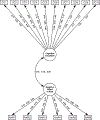Measurement invariance of intuitive cancer risk perceptions across diverse populations: The Cognitive Causation and Negative Affect in Risk scales
- PMID: 28810422
- PMCID: PMC7906483
- DOI: 10.1177/1359105317693910
Measurement invariance of intuitive cancer risk perceptions across diverse populations: The Cognitive Causation and Negative Affect in Risk scales
Abstract
Intuitive cancer risk perceptions may inform strategies to motivate cancer prevention behaviors. This study evaluated factor structure and measurement invariance of two new measures of intuitive cancer risk, the Cognitive Causation and Negative Affect in Risk scales. Single- and multiple-group confirmatory factor analysis models were fit to responses from three diverse samples. The confirmatory factor analysis models fit the data well, with all comparative fit indices (CFI) ≥ 0.94. Items flagged by chi-square difference tests as potentially non-invariant were largely invariant between samples according to practical fit indices (e.g. ΔCFI). These novel scales may be particularly relevant in diverse, underserved populations.
Keywords: cancer risk perceptions; confirmatory factor analysis; construct validation; diversity; measurement; measurement invariance; risk.
Figures

References
-
- Aiken LS, Fenaughty AM, West SG, et al. (1995) Perceived determinants of risk for breast cancer and the relations among objective risk, perceived risk, and screening behavior over time. Womens Health 1: 27–50. - PubMed
-
- Baser RE. (2017). PROscorer: Scoring Functions for Patient-Reported Outcome (PRO) Measures and Other Psychometric Instruments. R Package Version 0.0.1. Retrieved from http://CRAN.R-project.org/package=PROscorer
-
- Bentler PM (1990) Comparative fit indexes in structural models. Psychological bulletin 107(2): 238. - PubMed
Publication types
MeSH terms
Grants and funding
LinkOut - more resources
Full Text Sources
Other Literature Sources
Miscellaneous

